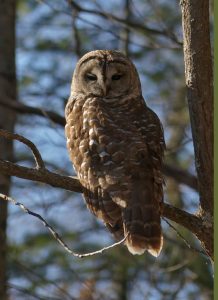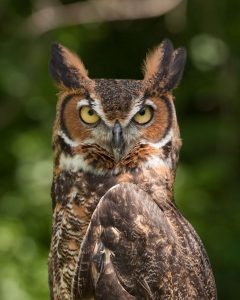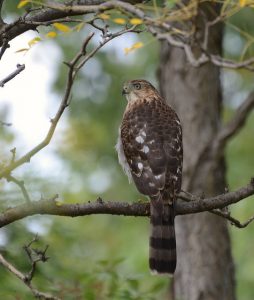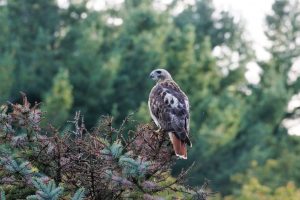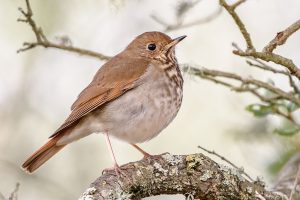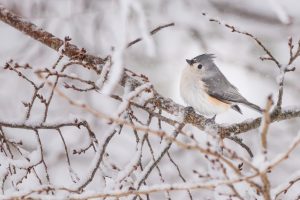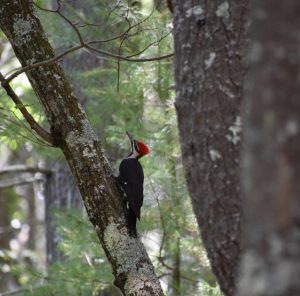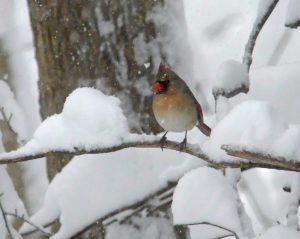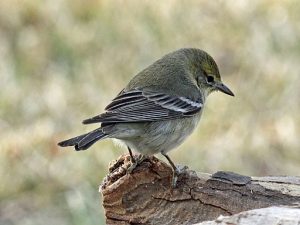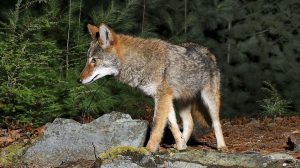Written by Gwyn Loud for the Lincoln Land Conservation Trust. She welcomes your sightings and questions at 781-259-8690 or gwynloud555@gmail.com. Norman Levey, coordinator for the Concord Area Christmas Bird Count is responsible for the CBC account.
For the 59th year Lincoln participated in National Audubon’s Christmas Bird Count. Lincoln is one of eighteen towns entirely or partially enclosed by a fifteen mile diameter circle centered on the corners of Stow, Maynard, Concord, and Sudbury and our circle is one of 2,580 in the Western hemisphere that census birds on a single day between December 14 and January 5. The Concord count was held this year on Dec. 30, 2018.
Fourteen field participants set out early morning in bright, cool, and calm weather while seven volunteers stayed in on the warm sides of their windows and counted birds at their feeders. One early-rising owler started out by car at 3:45 a.m. for known owl locations in Lincoln and two and half hours later had not heard or seen a one. Happily, two Eastern screech-owls and one great-horned spoke up just before dawn light. Northern barred owls were quiet before dawn but three were seen by three field parties during the day. Barreds will hunt in daylight and can be seen watching for prey from roosts in the forests and woodland edges. One bird counter was startled to see a sleepy-eyed barred owl perched seven feet over a private lane, unmoved by his close approach. Not a single Northern saw-whet was located on the count this year in Lincoln.
Flint’s Pond was open after an early December freeze-over and five species of ducks had returned: 14 common mergansers, seven hooded mergansers, four common goldeneyes, and singles of bufflehead and mallard. A lone herring gull was spotted on the pond later in the day.
Two species of hawks made the tally: 18 red-tails and one Cooper’s hawk. Red-tailed hawks numbered only a few circle-wide in the early days of the Concord count but with the aging of the forest trees, providing more nesting locations, and field and edge habitat suitable for robust numbers of voles and other rodents favored by the hawks, these large buteos are commonly seen circling individually or in pairs over every large agricultural field in town year round.
Notable this year were two rock pigeons, not commonly observed in Lincoln’s rural environment, though abundant in Concord, and a single fish crow, a cousin of our American crow, observed in flight calling continuously. This may be the first individual ever seen on the Lincoln count. Fish crows, identified easily by their high nasal call, usually prefer coastal locations.
Lincoln won the trophy for the winter hardy hermit thrush with a record seven, compared to only one reported elsewhere in the count circle. Culver Field had four in surrounding thickets showing a ripe crop of oriental bittersweet fruit, which hermit thrushes will dine on when little else may be spread on winter’s austere buffet table.
A single catbird was feeding in the briery edge of St. Anne’s marsh. Dumetella, the genus name for this plain gray bird with a black cap and rufous undertail means (in Latin I presume) “small thicket”, which perfectly describes the catbird’s preferred habitat. We don’t see gray catbirds very often in December as we live slightly beyond the very northern margin of their wintering range.
Drumlin Farm’s feeders hosted seven purple finches among the usual horde of house finches, now abundantly more common than the purples that were once the majority.
Looking at trends since the first Concord area CBC in 1960, several species seen on the first count such as ring-necked pheasant (94) and ruffed grouse (23) are all but totally absent today. Evening grosbeaks were a common spectacle on feeder boards and crab apples every year, peaking at 1,672 in 1983; this year the irruption missed us entirely for a total of zero. Pileated woodpeckers, tutfed titmice, and cardinals, now common, were rarities in 1960 and few robins over-wintered. 20,082 robins were counted this year, 210 in Lincoln but most at a roost in Wayland.
A special thanks to our skilled young birders who join us every year and contribute their keen eyes, ears, and knowledge to the count. Our guest birders spied a pine warbler wintering, aptly, on Pine Hill. Let us respect the bravery of this small warbler and all the other birds and wildlife settling into their winter home in Lincoln, for the frigid wind and harsh weather and scarcity impose a cruel and unforgiving test of animal adaptation and survival.
Many thanks to our participants, Barbara Peskin, Carol Peskin, Patti Cable, Pamela Sowizral (Drumlin Farm), Jason Forbes, Rob Todd, Bryce Wolf, Judy Marino, Ron McAdow, Aidan Pavao, Jess Sullivan, Kaija Gahm, Vin Durso, James Echmalian, Bonnie Echmalian, Greg Stathis, Marjorie Durand, Norman Levey, Jane Layton, John Dailey.
Norman Levey, coordinator for the Concord Area CBC, wrote the excellent account above. I was sorry to miss the event this year, being far away watching wildlife in Tanzania!
As for non-avian wildlife, people from several parts of town have reported coyotes, including an individual in the Weston Road area near the Weston town line, which looks like a red fox-coyote mix. In February coyotes will breed, pairs staying together for several seasons, and den sites are sought out and excavated in March. According to Mass Audubon, dens “are located on slopes, banks, or rocky ledges and are often hidden under downed trees, stumps, or in culverts. Although capable of digging their own den, they frequently enlarge abandoned burrows of woodchucks, foxes, or skunks.” Females will give birth to four- seven pups in April.
A correction from my December column: I incorrectly listed moles and shrews among rodents when they are actually insectivores; a sharp-eyed reader pointed out that “moles and shrews are not rodents because they lack the four incisors that continuously grow (“rodent” means chewer).”
© Gwyn Loud


